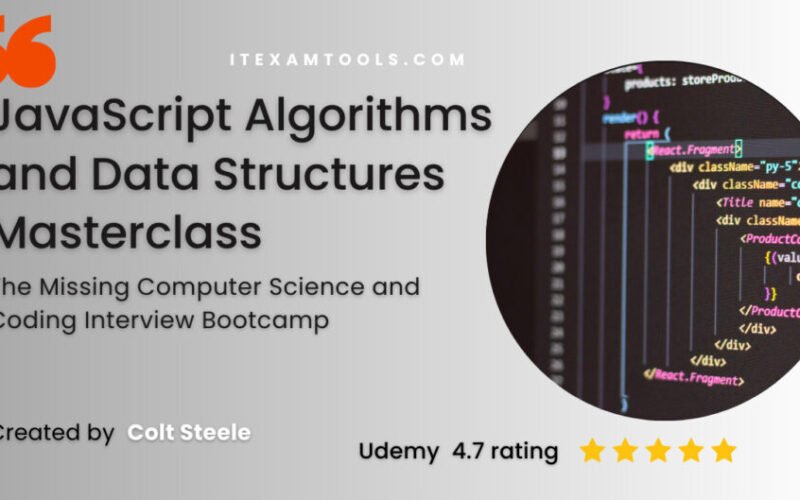Cisco OSPF Basic Configuration In this Cisco CCNA tutorial, you’ll learn how to do a basic configuration of OSPF on our Cisco routers. Scroll down for the video and also text…
JavaScript Algorithms and Data Structures Masterclass

The Missing Computer Science and Coding Interview Bootcamp
Elevate Your IT Career with the JavaScript Algorithms and Data Structures Masterclass
In the rapidly evolving world of IT, staying competitive and advancing your career requires a strong foundation in key programming concepts. If you’re an aspiring IT professional looking to sharpen your coding skills and enhance your problem-solving abilities, look no further than the JavaScript Algorithms and Data Structures Masterclass on Udemy. This comprehensive and affordable online course is your ticket to mastering the art of algorithms and data structures, two cornerstones of successful software development.
Unlocking the Power of Algorithms and Data Structures

Look what you are going to learn from this course
1. Learn everything you need to ace difficult coding interviews
Cracking the code to acing coding interviews is the holy grail for IT professionals. This course serves as your trusted guide, equipping you with the skills and strategies needed to confidently tackle even the most challenging technical interviews. You’ll gain a deep understanding of problem-solving methodologies and learn to approach complex coding scenarios with clarity and precision.
2. Master dozens of popular algorithms, including 6 sorting algorithms!
Algorithms are the building blocks of efficient code, and this masterclass leaves no stone unturned. With a focus on practicality, you’ll dive headfirst into dozens of popular algorithms, unraveling their logic and implementation. From sorting algorithms like Bubble Sort and Quick Sort to searching algorithms like Binary Search, you’ll build a robust toolkit to solve diverse coding challenges.
javascript// Sample Code: Quick Sort Algorithm function quickSort(arr) { if (arr.length <= 1) return arr; const pivot = arr[0]; const left = []; const right = []; for (let i = 1; i < arr.length; i++) { if (arr[i] < pivot) { left.push(arr[i]); } else { right.push(arr[i]); } } return [...quickSort(left), pivot, ...quickSort(right)]; }
3. Implement 10+ data structures from scratch
Data structures lay the foundation for organizing and managing data efficiently. In this course, you’ll roll up your sleeves and construct more than 10 essential data structures from scratch. From linked lists to hash tables, each implementation deepens your understanding of how data can be structured and manipulated, setting you on the path to becoming a data handling virtuoso.
javascript/ Sample Code: Linked List Implementation class Node { constructor(data) { this.data = data; this.next = null; } } class LinkedList { constructor() { this.head = null; } append(data) { const newNode = new Node(data); if (!this.head) { this.head = newNode; return; } let current = this.head; while (current.next) { current = current.next; } current.next = newNode; } // Other methods like prepend, delete, etc. }
4. Improve your problem-solving skills and become a stronger developer
Problem-solving is a crucial skill that separates average developers from exceptional ones. Throughout the course, you’ll be challenged with a myriad of real-world coding problems that will sharpen your ability to devise elegant solutions. With each successfully solved problem, your confidence will grow, and you’ll emerge as a more capable and resourceful developer.
Conclusion: Ignite Your IT Career with the Power of Algorithms and Data Structures
In the dynamic world of IT, proficiency in algorithms and data structures is not just a desirable skill – it’s a necessity. The JavaScript Algorithms and Data Structures Masterclass on Udemy offers an immersive learning experience that empowers you to conquer coding interviews, master essential algorithms, and craft efficient data structures.
By enrolling in this masterclass, you’re not just signing up for a course; you’re investing in your future as a formidable IT professional. Whether you’re a seasoned developer looking to level up or a newcomer eager to build a strong foundation, this course is your key to unlocking a world of opportunities.
Don’t let your career stagnate – take the leap and embark on this transformative journey. Enroll in the JavaScript Algorithms and Data Structures Masterclass today, and witness firsthand how your IT career is destined for new heights of success and innovation. Your future self will thank you for the investment in your skills and career growth.

here are 20 multiple-choice questions related to the JavaScript Algorithms and Data Structures Masterclass:
1. What is the primary focus of the JavaScript Algorithms and Data Structures Masterclass? a) Building user interfaces b) Mastering CSS styling c) Developing mobile applications d) Enhancing problem-solving skills
Answer: d) Enhancing problem-solving skills
2. Which fundamental concepts are emphasized in the course? a) Networking protocols b) Software licensing c) Algorithms and data structures d) Graphic design principles
Answer: c) Algorithms and data structures
3. What is a key benefit of mastering algorithms and data structures? a) Enhanced hardware compatibility b) Faster typing speed c) Improved debugging tools d) Efficient problem-solving in coding interviews
Answer: d) Efficient problem-solving in coding interviews
4. Which term refers to a set of step-by-step instructions for solving a specific problem? a) Algorithm b) Syntax c) Protocol d) Framework
Answer: a) Algorithm
5. Why are sorting algorithms important in programming? a) They help secure data b) They improve network connectivity c) They organize data in a specific order d) They enhance user interface design
Answer: c) They organize data in a specific order
6. Which sorting algorithm is known for its efficient average and worst-case performance? a) Bubble Sort b) Selection Sort c) Merge Sort d) Insertion Sort
Answer: c) Merge Sort
7. What is the main purpose of a data structure? a) Enhancing visual aesthetics b) Managing network connections c) Organizing and storing data efficiently d) Optimizing code compilation
Answer: c) Organizing and storing data efficiently
8. Which data structure operates on the principle of “last-in, first-out” (LIFO)? a) Linked List b) Queue c) Hash Table d) Stack
Answer: d) Stack
9. What is the primary benefit of using a linked list data structure? a) Constant time lookup b) Efficient sorting c) Dynamic size allocation d) Real-time collaboration
Answer: c) Dynamic size allocation
10. Which type of search algorithm is more efficient for sorted arrays or lists? a) Linear Search b) Binary Search c) Depth-First Search d) Breadth-First Search
Answer: b) Binary Search
11. What does “Big O notation” represent in algorithm analysis? a) The number of functions in a program b) The maximum number of operators allowed c) The runtime complexity of an algorithm d) The amount of memory allocated for data
Answer: c) The runtime complexity of an algorithm
12. Which data structure efficiently stores key-value pairs and allows fast lookups? a) Array b) Stack c) Hash Table d) Queue
Answer: c) Hash Table
13. In the context of algorithms, what is the purpose of a “recursive” function? a) To perform arithmetic operations b) To divide tasks into sub-tasks of the same type c) To iterate through a loop d) To generate random numbers
Answer: b) To divide tasks into sub-tasks of the same type
14. Which sorting algorithm has the worst-case time complexity of O(n^2)? a) Merge Sort b) Quick Sort c) Bubble Sort d) Radix Sort
Answer: c) Bubble Sort
15. What is the primary advantage of a linked list over an array for inserting and deleting elements? a) Linked lists use less memory b) Linked lists provide constant-time access c) Linked lists offer faster random access d) Linked lists have better cache locality
**Answer: d) Linked lists have better cache locality16. Which algorithm efficiently searches for a target element in a sorted array by repeatedly dividing the search range in half? a) Quick Sort b) Linear Search c) Depth-First Search d) Binary Search
Answer: d) Binary Search
17. What does a Hash Table use to quickly locate a value associated with a particular key? a) Indexing b) Sorting c) Hashing function d) Recursion
Answer: c) Hashing function
18. Which data structure is designed to maintain a first-in, first-out (FIFO) order for elements? a) Stack b) Linked List c) Queue d) Hash Table
Answer: c) Queue
19. Which concept is fundamental to efficient algorithm design and helps estimate its performance under varying inputs? a) Abstraction b) Polymorphism c) Inheritance d) Algorithmic complexity analysis
Answer: d) Algorithmic complexity analysis
20. How does mastering algorithms and data structures contribute to becoming a stronger developer? a) It improves typing speed b) It enhances creativity in design c) It enhances problem-solving skills and code efficiency d) It focuses solely on visual design aesthetics
Answer: c) It enhances problem-solving skills and code efficiency








